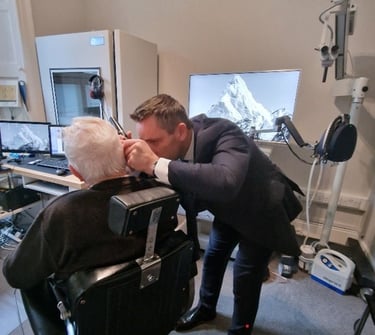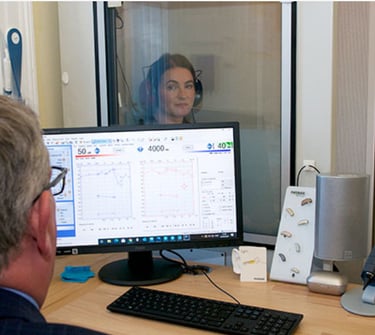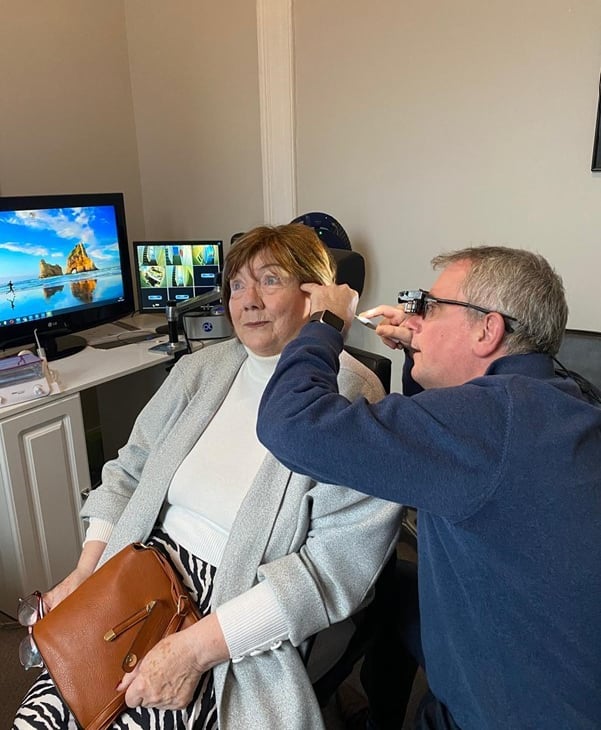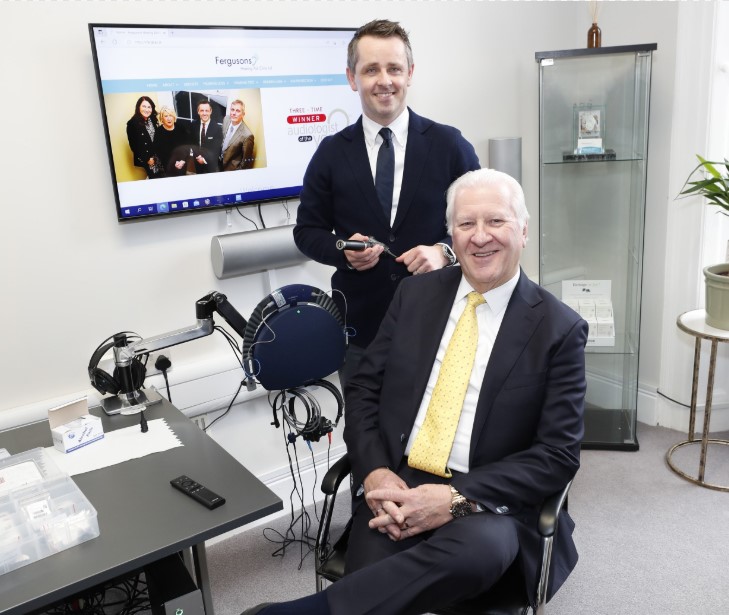
Understanding Your Hearing Test
Assessment – Initial Test
In our clinic you will always be seen by a university qualified hearing aid audiologist.
The initial hearing test and assessment takes approximately one-and-a-half hours.
The Hearing Aid Audiologist will test your hearing in a number of different ways.
The various tests are neither painful or uncomfortable.


Case History
Firstly, a detailed case history is taken to determine the current concerns about your hearing or related symptoms. This will include questions about past medical conditions of the ear, exposure to loud noise, any health problems, medication taken and family history of hearing problems.


Checking Out Your Ears
Following on from this, both outer ears will be examined with a video otoscopic camera to check for any abnormalities in the ear canal or eardrum, or for any wax.
Your hearing is then tested in a sound booth in a sound treated room. Tones of various pitches are presented through either a set of headphones over your ears or a small set of earplugs in your ears. Next, a bone conductor headband is placed behind your ear on the temporal bone. The bone conductor transmits sound through bone vibration to the inner ear and helps determine the type of hearing loss that might be present. A map of hearing (audiogram) of these tones is then created for each ear.
Speech tests are also used to determine, not just that you can hear that speech is present, but the level at which you can detect and understand speech.
Tympanometry is a test that shows how well the eardrums are conducting sound, and will determine if there are any problems with the mechanical parts of the ear. Real Ear Measurement (REM), which is the measurement of sound in the ear canal, is carried out. This important test affects the way a hearing aid is programmed for you at a later stage.


Your Test Results Explained
After the various tests are completed, the Hearing Aid Audiologist will take the time to explain the test results to you and advise you accordingly. If hearing aids are not needed or if referral to a doctor or Ear, Nose and Throat consultant is necessary, we will inform you. If hearing aids are indicated, discussion can then take place to determine the most appropriate solution for your hearing loss.


Solutions – Hearing Aids Or Not
Are Hearing Aids Needed or Not?
If so, one aid or two?
A bilateral fitting is when two hearing aids are worn. There are many advantages to listening with two ears instead of one. Wearing a hearing aid in both ears is called a bilateral fitting.
The following are some of the benefits of wearing two hearing aids:
Superior overall sound quality.
Clearer speech during normal listening situations.
Better understanding in group conversations and situations where background noise is present.
More relaxed hearing because there is no straining to hear with the “good ear”.
Bilateral amplification allows for lower volume control settings in both aids, which allows sound to be heard more comfortably.
Ability to more easily locate sources and directions of sound.
A feeling of more balanced sound.
A bilateral fitting can help suppress tinnitus in both ears.
Where there is a hearing loss in both ears wearing two hearing aids prevents the brain losing some of its information processing ability. If only one hearing aid is worn the ability to understand speech is reduced in the ear that is not stimulated with a hearing aid.
We will advise you if you are in the minority of people for whom two hearing aids are not be suitable.
If you don’t want to get hearing aids right now
After your assessment you will be advised that if you have a mild hearing loss, you may need to have it monitored over a 12 to 24 month period.
If the loss is conductive, we may need to refer you to your GP or an Ear, nose and throat specialist, should we feel your Hearing Loss needs to be addressed medically.
Your records will be held on file so that at any time in the future they are available for reference as a starting point from which to proceed. Any medical reports or referrals are forwarded to the relevant professionals.
If you require Hearing Aids but are not ready just yet, your records will also be held on file.
If you want to get hearing aids now
If you are ready to engage with Hearing Aid amplification, a discussion will follow and we will advise as to the most appropriate and most comfortable hearing aid(s) to suit your budget and your hearing assessment. Impressions are taken of one ear or both ears if this is necessary, if two hearing aids are decided upon. The manafacturer’s laboratory uses these impressions to craft the In-The-Ear hearing aid(s) or ear mould in the case of a Behind-The-Ear hearing aid(s). We always use computer aided design (CAD) for this process with the exeption of silicon moulds. In Many cases impressions are not required for thin tube on-the-ear or thin tube receiver in-the-ear hearing aids. Measurements will be taken at this stage to determine the size of these fittings.
Fitting
Fitting your new hearing aid(s) takes approximately one hour.
The aid(s) are programmed and set by the Hearing Aid Audiologist to suit your specific hearing loss and lifestyle.
Full instructions on the handling, use and care of hearing aid(s) are given. Habilitation advice – a plan or schedule as to how to start wearing the hearing aids is suggested.
A further appointment is made for review and adjustment.
Review Appointment
A personalised rehab programme is paramount to the success of you adapting to your Hearing Aids.
This appointment is approximately thirty minutes and is a very important appointment. Your progress is reviewed and appropriate adjustments are made to the hearing aid(s). Rehabilitation is provided if this is necessary. Further follow-up appointments are arranged as required.
The Longer Term
Six monthly maintenance checks and yearly annual reviews where we re-test your hearing are provided in your after care programme, to ensure your deriving maximum benefit from your hearing aid.
All our hearing aids carry a four year warranty. This covers all your consultation appointments and servicing. Also included are repairs to hearing aids with the exception of loss or physical damage due to misuse.
Get In Touch
Address
61 Catherine St, Prior's-Land, Limerick, V94 078P, Ireland
Contacts
Tel: +353 (0) 061 313 633
WhatsApp: +353 87 360 7747
info@ferghac.ie
Opening Hours
Monday - Friday:
9:00 AM - 5:00 PM
Saturday - Sunday:
Closed
We close for our lunch hour from 1-2.
We are closed bank holidays, St Patrick's Day & Good Friday
Services
